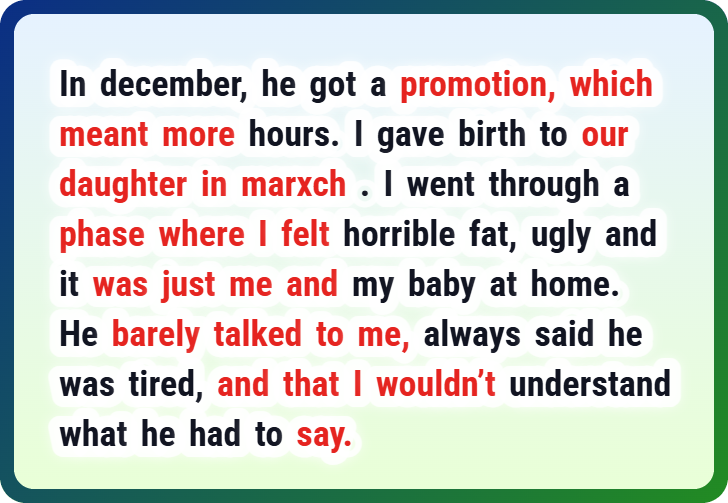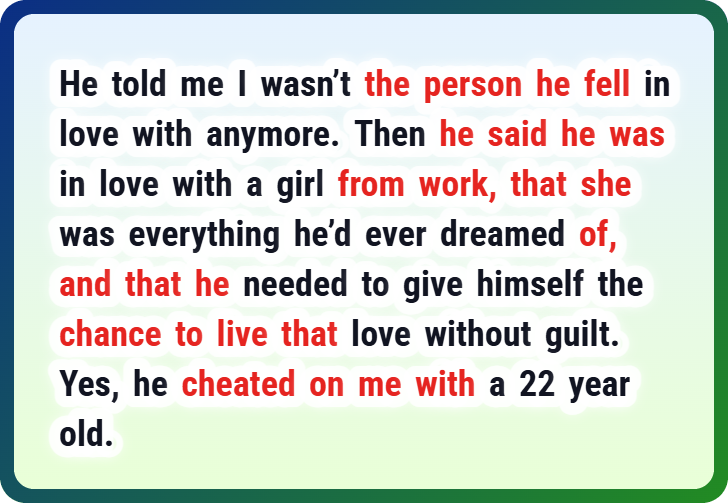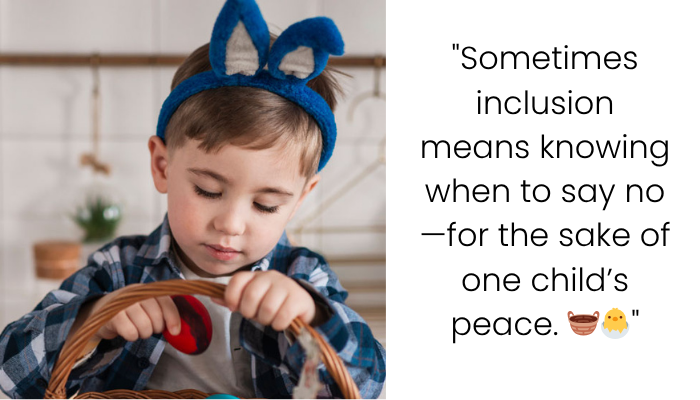He Left Me For a 22-Year-Old—All I Could Think About Was the House Décor

At 34, after ten years together and seven of marriage, this woman built what many would call a dream life: a loving home, two daughters, and a house lovingly filled with warmth, charm, and personalized beauty. But behind the pristine kitchen and the perfect garden swing, cracks began to form. When her husband, 41, finally revealed he was leaving her for a 22-year-old coworker, she didn’t scream, cry, or ask “why”—she clutched her infant, stood stunned, and mourned her home décor. That moment—raw, real, and oddly specific—resonated with thousands. Because it wasn’t about the curtains, it was about identity, emotional trauma, financial security, and how infidelity unmoors even the most grounded among us. It spoke to the loss of investment, both emotional and financial, that comes with a marriage breakdown, and how betrayal doesn’t just end love—it shatters stability, self-worth, and the sense of home. Here’s why her reaction was not just valid, but profoundly symbolic—and what it teaches us about divorce recovery, coping with betrayal, and emotional survival in the aftermath of infidelity.
Advertisement – Continue Reading Below
Infidelity can destroy a marriage in one fell swoop

For this couple, it began when the husband got promoted













1. When Betrayal Targets the Invisible Labor
The home wasn’t just a house—it was her canvas, her sacrifice, her safe place. Studies in relationship psychology say women, especially caregivers, often pour themselves into homemaking as emotional labor (Psychology Today, 2023).
So when her husband walked out—not just with infidelity, but with the classic “I don’t love who you’ve become” speech—it cut deeper than romance. It erased her years of sacrifice, her identity as nurturer, and the invisible work that kept the family stable.
Advertisement – Continue Reading Below
Decorating wasn’t about pretty curtains or Pinterest boards. It was survival. It was her way to preserve meaning through motherhood and emotional trauma. So yeah, when everything cracked, the first thing she grabbed onto was the wallpaper, the kitchen tiles, and that garden swing.
2. Why She’s Not “Shallow” for Grieving the House
To some people, breaking down over home décor sounds shallow. But neuroscience proves otherwise: in moments of emotional trauma, the brain latches onto physical objects to process abstract loss (Harvard Medical School, 2021).
Her partner wasn’t hers anymore—but the house still was. And when infidelity destroys your marriage, your mind clings to what feels solid. The kitchen, the furniture, the garden—those weren’t random. They were her anchors in chaos.
Advertisement – Continue Reading Below
Her grief wasn’t about paint colors. It was about losing stability, security, and the one space that reflected her.
3. The Home as a Mirror of Identity
Research in the Journal of Environmental Psychology (2018) shows that interior design is a deeply expressive act. For many stay-at-home moms who left careers, it’s their silent biography.
Every corner of her home—the vegetable patch, the kitchen layout, the cozy reading chair—was her storytelling. They weren’t “decorations,” they were her way of having control in a life where many choices were already taken.
Advertisement – Continue Reading Below
So when her husband dismissed her, it wasn’t just the end of love—it was the devaluing of her very identity. And her response? Yelling about the house. Because that was still hers.
4. Infidelity and the Narcissist’s Exit Strategy
Her husband leaving for a 22-year-old coworker is straight from the narcissistic betrayal playbook. Experts note narcissistic partners often chase admiration during transitions like after a baby or job changes (Verywell Mind, 2024).
The whole “you’ve changed” line? Classic emotional manipulation. It shifts blame away from him and onto her. She didn’t suddenly become unlovable—she became inconvenient to his ego and fantasy life. Her years of emotional labor and sacrifice didn’t disappear; he just chose not to value them.
Advertisement – Continue Reading Below
5. The Power of Symbolic Rage

When she snapped about the wallpaper and the décor, it wasn’t nonsense. It was symbolic rage.
Psychologists call this symbolic grief—mourning something tangible that represents a much deeper wound (APA.org, 2020).
Her rage wasn’t about a lamp or the swing. It was about being unseen, unheard, unappreciated. The house was her proof of effort, her visible contribution. And now it was being taken away. Meanwhile, he still wanted to be viewed as the victim.
Advertisement – Continue Reading Below
6. Legal and Emotional Survival After Neglect
Thankfully, she started leaning on her support system—her mom, his brother, his mother. People who validated her worth when he didn’t. And now? She’s talking to a divorce lawyer.
That’s huge. Because divorce isn’t just paperwork—it’s about financial security, housing rights, and emotional survival.
Some key things women in this situation should know:
Advertisement – Continue Reading Below
- Secure housing rights early: If her name’s on the deed or lease, she may have claim to stay.
- Document emotional labor: Courts are starting to consider unpaid caregiving as significant in divorce settlements.
- Watch for gray divorce risks: Mid-life breakups often leave stay-at-home partners financially vulnerable (CNBC, 2024).
Moving from emotional chaos to legal clarity is one of the most powerful steps she can take.
7. From “Housewife” to Homeowner of Her Healing
Healing after betrayal isn’t about revenge. It’s about reflection and rebuilding. She might lose the house. She might fight for it. But the truth is, the real reclamation is about her identity.
That garden swing? That kitchen? Those weren’t just décor. They were proof of her resilience. And whether or not she keeps the house, she will still rebuild herself.
Advertisement – Continue Reading Below
Thousands resonated with her story because they’ve been there too—where grief gets tangled in wallpaper and curtains. And that’s okay. Symbolic grief is still grief. And every tear shed over décor was really a tear for herself.

Final Thoughts: This Was Never About the Curtains
This story went viral because it speaks to something rarely said out loud: when women are discarded, what they lose isn’t just the partner—it’s the life they built piece by piece.
If she mourned the curtains, it’s because she hung them with her own hands.
If she screamed about the kitchen tiles, it’s because she cooked every family meal there.
If she clung to décor, it’s because nothing else felt real anymore.
Advertisement – Continue Reading Below
And if you’ve ever felt that way? You’re not weak. You’re not shallow. You’re grieving. And grief doesn’t always look polished. Sometimes it looks like screaming over wallpaper while holding your baby in your arms.
But that’s where healing starts. Because from that same place of loss, you’ll also start planting something new—your independence, your confidence, and your future.
The woman provided more context to her story












